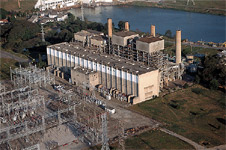
Piratininga
Thermoelectric Power Plant
The important industrial
development occurred in the São Paulo area after the last World War,
resulted in an increased electricity consumption, and made evident the need
for the enlargement of the energetic complex. The hydrological unfavorable
period during the beginning of the 50's resulted in an electric energy rationing,
proving the need to provide the generator system with a strategic part of
the thermoelectricity. Hence, the Piratininga Thermoelectric Power Station
was built in the banks of the Pinheiros Channel, next to the Billings Reservoir,
and it started its operation in November 15, 1954, with its two first generators
with an initial installed capacity of 200 MW. Afterwards, due to the industrial
expansion of that area, this capacity was increased, with the implementation
of two more sets of turbines with 136 MW each, which were inaugurated in 1960,
increasing the total generation capacity to 472 MW. Focusing on the improvement
of air quality in the middle of the 80's, the fuel used was replaced by one
that was less polluting (low sulfur content oil) . Since August 2000, the
power station is progressively using natural gas, enjoying the economic and
environmental advantages offered by this type of fuel. A consortium was formed
with Petrobras, in January 2001, so that the two companies may
perform
the implementation of four combined-cycle gas turbines, increasing the overall
production capacity.